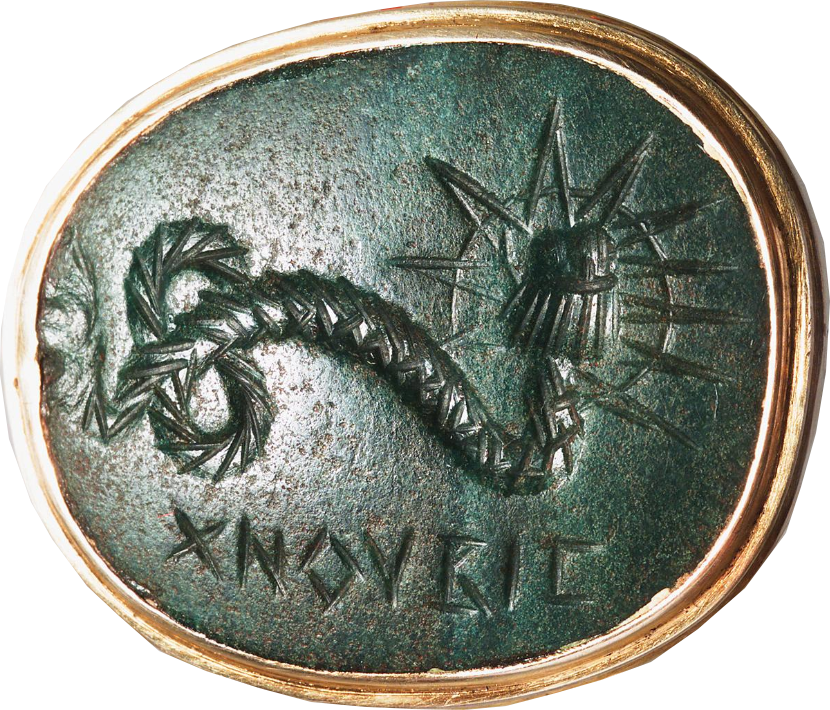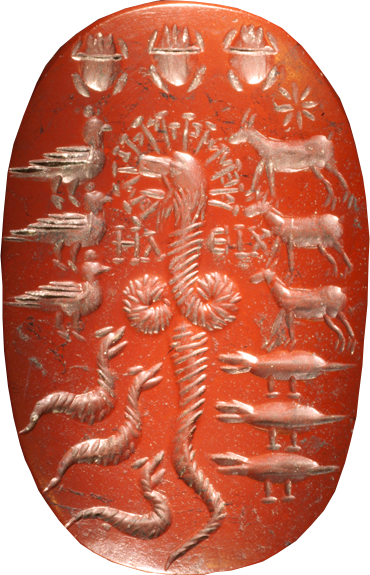Ancient Psychedelia: Alien Gods & Mushroom Goddesses
Online Book - Chapter 10, Page 158
Back to Online Book Mainpage / Next Page (Chapter 10, Page 159)
 (39h) Kneph intaglio c. 100-600 AD (39h) Kneph intaglio c. 100-600 ADCneph, the First Phoenix There was a version of the “phoenix” in Egypt, which changed slightly by the time Greece adopted it. The phoenix as many are aware, is both bird and serpent. The writings of Eusebius have brought forth a small gem or two in research. I found this in regard to immortal and self-consumed: “The nature then of the dragon and of serpents Tauthus himself regarded as divine … We have spoken more fully about it in the memoirs entitled Ethothiae, in which we prove that it is immortal, and is self-consumed, as is stated before: for this animal does not die by a natural death, but only if struck by a violent blow. The Phoenicians call it ‘Good Daemon,’ in like manner the Egyptians also surname it Cneph; and they add to it the head of a hawk because of the hawk's activity.” Eusebius then goes onto say: “Epeïs also (who is called among them a chief hierophant and sacred scribe, and whose work was translated [into Greek] by Areius of Heracleopolis), speaks in an allegory word for word as follows: ‘The first and most divine being is a serpent with the form of a hawk, extremely graceful, which whenever he opened his eyes filled all with light in his original birthplace, but if he shut his eyes, darkness came on.’ … ‘Moreover the Egyptians, describing the world from the same idea, engrave the circumference of a circle, of the colour of the sky and of fire, and a hawk-shaped serpent stretched across the middle of it, and the whole shape is like our Theta (θ), representing the circle as the world, and signifying by the serpent which connects it in the middle the good daemon’.” This final paragraph is lengthy but I thought important to include in order to show the true insightful perspective into the ancient Greek/Christian mindset. Not everyone was as bright as we may assume. Mythology gets the best of ‘em, and it even got me, for many years. This next paragraph shows how the naive mind views allegory: “From Tauthus, as is said above, all received their impulse towards physiological systems: and having built temples they consecrated in the shrines the primary elements represented by serpents, and in their honour celebrated festivals, and sacrifices, and mystic rites, regarding them as the greatest gods, and rulers of the universe. So much concerning serpents. |
“Such then is the character of the theology of the Phoenicians, from which the word of salvation in the gospel teaches us to flee with averted eyes, and earnestly to seek the remedy for this madness of the ancients. It must be manifest that these are not fables and poets' fictions containing some theory concealed in hidden meanings, but true testimonies, as they would themselves say, of wise and ancient theologians, containing things of earlier date than all poets and historians, and deriving the credibility of their statements from the names and history of the gods still prevailing in the cities and villages of Phoenicia, and from the mysteries celebrated among each people: so that it is no longer necessary to search out violent physical explanations of these things, since the evidence which the facts bring with them of themselves is quite clear. Such then is the theology of the Phoenicians: but it is now time to pass on and examine carefully the case of the Egyptians.” (39) Cneph, (Kneph) as the hawk-headed serpent or the Phoenix bird, is shown in ancient Egyptian religious art as a winged egg or a globe with a serpent wrapped around it. (40) In Greek, Chnuphis, a similar figure and related linguistically, is serpent-bodied and lion-headed ("leontoeidic") and is commonly featured on magical amulets for protection. (41) Despite his description as being serpent headed (39f), almost all the image descriptions of Cneph, such as those on Graeco-Egyptian amulets from 100-600 AD, relate him as lion-headed (39c, d, e). We can see that Cneph was also considered Abraxas by the Greeks.  (39h) Chnoubis Variation on Egyptian Intaglio c. 200-300 AD (39) Eusebius of Caesarea: Praeparatio Evangelica (Preparation for the Gospel). Tr. E.H. Gifford (1903) -- Book 1 (40) The Egyptian revival: ancient Egypt as the inspiration for design motifs in the west, James Stevens Curl, p.445, Psychology Press, Nov 2005 (41) Lynn Thorndike (1958). A History of Magic and Experimental Science. Columbia University Press. pp. 317–318, 379; https://en.wikipedia.org/wiki/Kneph (39h) © Genevra Kornbluth |
Go Back to Page 157